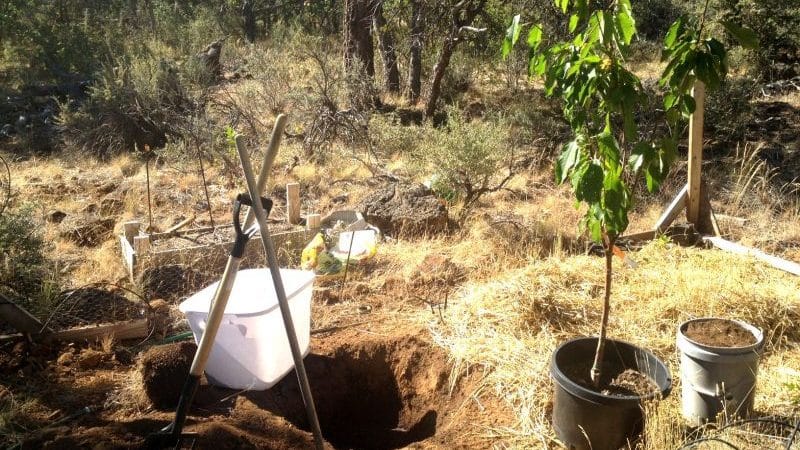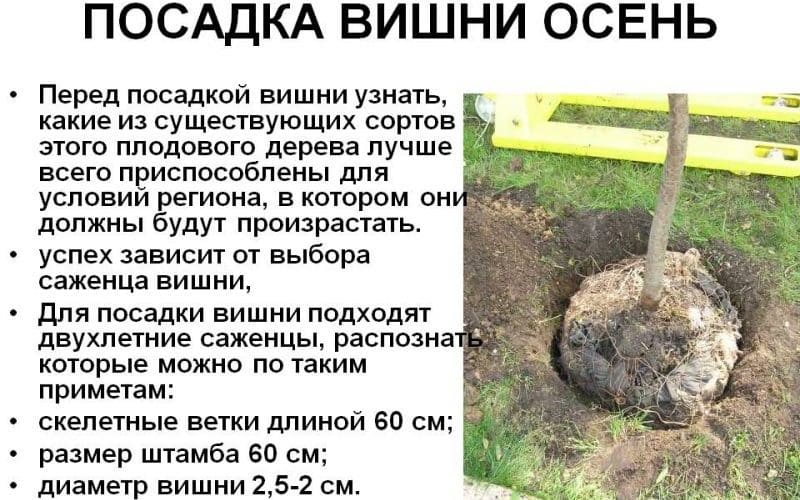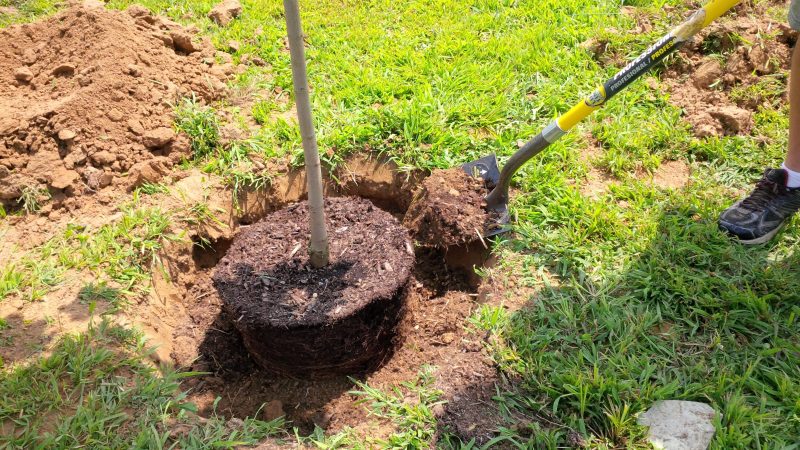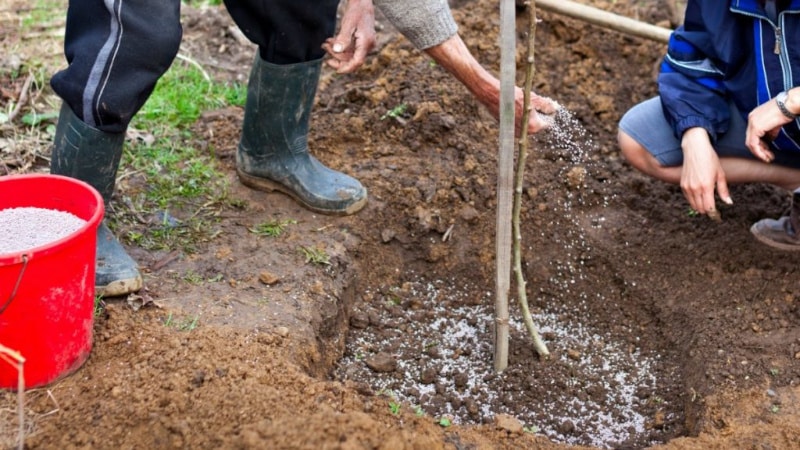How to properly plant cherries in the fall: instructions for a novice gardener
In many summer cottages you can find cherries. But not all novice gardeners know what time of year is best to plant this fruit tree.
We'll tell you when and how to plant cherries correctly and what to pay attention to so that they take root and bring a good harvest in the future.
Choosing a cherry variety for autumn planting
If you want to plant cherry seedlings in the fall, give preference to frost-resistant varieties, so that they successfully survive the winter and take root by spring:
- Altai early;
- Blizzard;
- University;
- Maksimovskaya;
- Chocolate girl.
These varieties tolerate frosty winters and cold summers well.
Also, when choosing, pay attention to the characteristics of pollination. Many varieties of cherries are self-sterile; they need a pollinator as a pair. In terms of ripening time, they should be close to each other. For full fruiting, choose 3-4 seedlings of different varieties.
Selection and preparation of seedlings

For autumn planting, select seedlings that have already entered the dormant period. This means that they should be without leaves and young shoots. Then the plants will use all their strength to take root.
The root system should be well developed and reach 25 cm.
One- or two-year-old trees are optimal for planting in the fall. The height of the seedlings should be no more than 100 cm, and the bark should be brown.
Attention! If the height of the seedling exceeds 100 cm or the bark has a greenish tint, it means that the plant has been “overfed” with nitrogen, and this stimulates active vegetation and reduces winter hardiness.
Selecting a location
An adult tree does not tolerate transplantation well. Therefore, before planting cherries, choose a suitable place. This should be a well-lit area on a hill, protected from wind and drafts. It is important that there are no trees nearby that will shade the cherry tree.
Cherry is sensitive to waterlogging, so swampy areas and places with close groundwater are avoided.
Reference. With proper care, cherries grow in one place for 15-20 years and bear fruit successfully.
Cherry prefers to grow on sandy and loamy soils. Soil acidity should be within normal limits. If the soil is very acidic, it is limed in advance (400 g of lime per 1 m²). This procedure is not carried out in the year the seedlings are planted.
Landing dates
In autumn, cherries are planted from mid-September to the end of October. It is important to plant seedlings before the first frost, 20-30 days before the onset of frost, so that the roots have time to strengthen. They focus on the average temperature in the region over past years.
The optimal disembarkation temperature is +10...+15°C during the day and not lower than 0°C at night.
Attention! If the air temperature is too high, the plant will not be dormant. Energy will be spent on developing shoots, not roots, and the root system will not have time to prepare for wintering.
When is it better to plant - in spring or autumn?

Planting cherries in the fall has many advantages compared to spring:
- In autumn, seedlings quickly adapt to transplantation. They are already in a state of rest, when all their energy is spent not on shoots and foliage, but on rooting before wintering.
- Good survival rate. In autumn, a favorable temperature regime is established for seedlings without sudden temperature changes.
- Large selection of planting material. In the fall, many gardeners sell cherry seedlings cheaper, there is a greater variety of varieties, so you can choose the right one. In addition, in the fall, seedlings are sold with an open root system, which makes it possible to carefully examine the root. It must be free of defects and fully developed.
- Autumn planting saves time. Apart from properly planting and covering the tree for winter, the gardener does not need to do any other work. Seasonal rains will provide the seedlings with moisture.
The autumn planting method also has disadvantages:
- Premature frosts can destroy the roots of the plant. The seedlings will not take root and will die.
- Rodents can damage seedlings. Young shoots are wrapped in protective material or painted with repellent whitewash.
How to properly plant cherries in autumn

When planting in autumn, it is important to remember that the root system must become stronger before the onset of frost. Therefore, they are preparing for the procedure.
Required materials and tools
Prepare the mixture in advance to fill the planting hole. To make it you will need:
- the top layer of soil remaining after digging a hole;
- 1 bucket of humus;
- 1 bucket of peat;
- 50 g superphosphate.
Nitrogen fertilizers are not used during planting, as they reduce the survival rate of seedlings.
From your inventory you will need:
- peg for support;
- pruner;
- leg-split;
- roofing felt;
- bucket with water;
- shovel.
Step-by-step instruction
In order for the cherry tree to grow and develop successfully, follow the planting rules:
- Before planting, leave the seedling in water for a day so that the roots are saturated with moisture.
- Carefully inspect the seedling and remove damaged roots with pruning shears.
- Pre-water the planting hole with water and allow it to soak.
- Place the seedling in the center of the hole, cover it with earth and compact it.
- Install a support on the north side and tie the seedling to it using elastic twine with a loop in the shape of a figure eight. They make a layer of roofing felt between the tree and the rope so that the bark is not injured by the wind.
- Water the seedling with a bucket of water. The soil is mulched at the base to prevent moisture from evaporating too quickly. Sawdust or pine needles are used as mulch.
Further care of the seedling

The most important thing for young cherries is timely watering and protection from pests. In the absence of regular rainfall, water the tree with at least 5 liters of water. A hole is made around the trunk for irrigation, and after the onset of cold weather, it is filled in so that melt water does not stagnate there in the spring.
Before frost, the seedling is hilled up to a height of 30 cm and covered with spruce branches on top so that the roots do not freeze in winter.
If the winter is not snowy, they shovel the snow towards the center of the trunk so that the surface of the hole is always under a thick layer of snow.
In spring, remove the protective layer and level the ground at the base. The branches are cut by a third to regulate the ratio of above-ground and underground parts.
Also at this time of year, preventive treatments are carried out against bacterial and fungal infections. The plant is treated against pests with the preparations “Akarin”, “Iskra bio”, “Fitoverm”. It is important to get rid of the larvae in the bark and soil before the tree begins to bear fruit, otherwise the harvest cannot be saved.
After flowering, during the fruiting period and at the beginning of the autumn period, cherries are watered abundantly. 40-60 liters of water are needed per 1 m².Once every three years, humus or compost is added at the rate of 0.5 buckets per 1 m².
In case of poor development, the seedling is fertilized with organic fertilizing from the following components: 1 bucket of manure, 5 buckets of water, 1 kg of ash. The consumption rate for 1 seedling is 0.5 buckets of fertilizer.
Nuances of planting depending on the region
Depending on climatic conditions in different regions of the country, cherries are planted at different times.
In the Urals and Siberia, frosts come earlier, so planting is carried out in early September so that it has time to adapt.
For the middle zone, the optimal planting time is late September - early October. This will allow the plant to go into dormancy and prepare for winter.
In the Volga region, cherries are planted in mid-October, when optimal conditions for rooting are established.
In the southern regions, planting occurs from early October to mid-November.
In regions with cold climates, you will have to postpone planting cherries until spring.
This is interesting:
Technology for planting potatoes with a walk-behind tractor.
A guide on how to plant cherries correctly in the fall and avoid mistakes.
Step-by-step instructions for planting cherry plum in the fall.
Conclusion
Planting cherries in the fall is not difficult; even a novice gardener can do it. The main thing is to take a responsible approach to the choice of seedlings and location, wait for the optimal temperature and follow the rules of planting and further care.